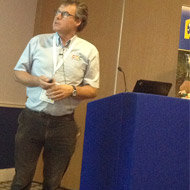Emphasis on critical appraisal

Peter Orpin told delegates that there is a significant profit opportunity to be realised by reducing the costs from culling.
Highlighting this, Professor Jon Huxley from Nottingham University, referred to the importance of early detection and effective treatment of claw horn lesions – predominantly sole ulcer/haemorrhage and white line disease. He pointed out that surprisingly little is known about these conditions, and although the aim on farm is to provide rapid resolution of clinical signs, there is no reliable research in the literature to give practical guidance on how best to do this.
He suggested that we are all inherently incapable of objective assessment of cases because it is part of human nature to have a bias towards the actions that we believe are right. So the only way to make critical appraisals of treatment and outcomes is to run well-controlled randomised trials.
To underline this point, Prof Huxley shared the results of just such a randomised study, carried out by his colleagues at Nottingham, to assess the best practical approach to the treatment of early claw lesions.
The trial showed that the best results were achieved from a combination of hoof trimming, application of a physical block to the sole and the systemic injection of a non-steroidal anti-inflammatory drug, even in very early cases in which there were only small visible changes to the sole but no detectable changes in gait.
Prof Huxley said that although farmers say they report cases of lameness in two days, the reality is that, on average, they actually report them after 65 days. The reason is that they tend to reserve the term 'lame' for severe cases when the condition is advanced, requires urgent action and is likely to recur. The evidence is that there are much greater economic and welfare advantages to be gained by detection and appropriate treatment at the very early stage.
In a separate presentation, Peter Orpin from Park Veterinary Group, Whetstone, told delegates that there is a significant profit opportunity to be realised by reducing the costs from culling; but it is reliant on accurate measurement and analysis of all the reasons for culling within an individual herd.
Increased culling in early lactation is an indicator that all is not well, and farmers should aim at a cull rate of no higher than 3% in the first 100 days of lactation. Replacing a cow with a heifer means that you are only replacing 75 per cent of the milk yield; and the loss is even greater when the cow is culled within 50 days because of the loss of a significant part of her lactation.
By retaining high risk 'problem' cows – often for sentimental reasons – farmers are storing up trouble for the future, and these animals have a negative effect on fertility and herd profitability. So-called 'involuntary' culls that leave the herd as a consequence of sickness, accident or death, are rarely seen by the vet but represent a significant cost to the farm enterprise and can highlight major health and welfare issues too.
By reducing losses from preventable physical causes of culling – for instance, surfaces that present a high risk of slipping and doing the splits or slipping when expressing bulling activity – it is possible to have a significant effect on reducing losses from culling. Often all that is required is a walk round the farm to identify likely sources of such problems and the implementation of simple remedial action.



 RCVS Knowledge has welcomed Professor Peter Cockcroft as editor-in-chief for Veterinary Evidence.
RCVS Knowledge has welcomed Professor Peter Cockcroft as editor-in-chief for Veterinary Evidence.